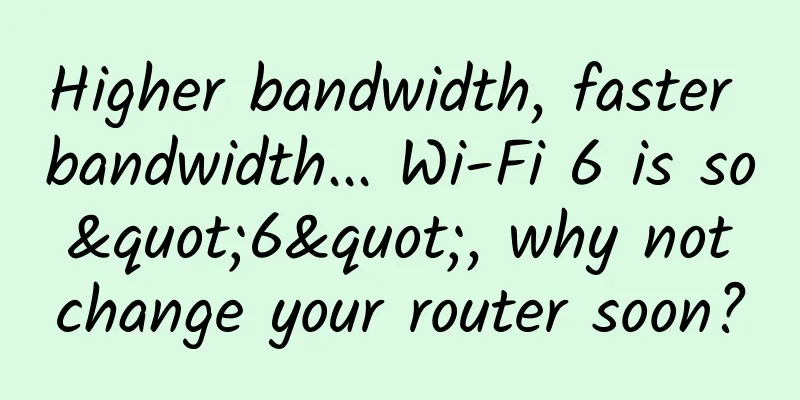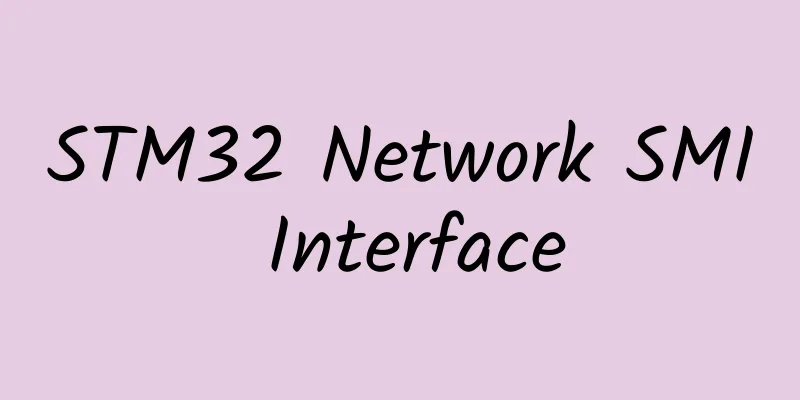Higher bandwidth, faster bandwidth... Wi-Fi 6 is so "6", why not change your router soon?

|
I'm afraid everyone is familiar with Wi-Fi, and Wi-Fi 6 is the sixth and latest upgrade of this wireless technology. Wi-Fi 6 has made technical improvements and optimizations in modulation, coding, multi-user concurrency, etc. Compared with speed improvement, it pays more attention to the overall optimization of applications, user experience, and wireless environment. It is more suitable for the current scenario of multiple Wi-Fi terminals and multiple applications. At present, there are many types of terminals and applications, such as video applications and instant messaging applications. Therefore, there are more and more cases of multi-concurrency and short messages in wireless scenarios. The early Wi-Fi protocol has no technical advantage in dealing with such scenarios, and Wi-Fi 6 has made a lot of improvements and optimizations for these scenarios, which can greatly improve the user's wireless experience. From the technical standards, the paper strength of Wi-Fi 6 is unquestionable, with a maximum theoretical speed of 9.6Gpbs. In comparison, Wi-Fi 5 only has 6.9Gbps, and the speed of a single spatial stream at 80MHz has increased from 433Mbps to 600.4Mbps. In addition, I believe everyone has also seen a lot of new features in the publicity of various router manufacturers. Today, I will introduce in detail how Wi-Fi 6 is stronger than Wi-Fi 5. 01. 1024-QAM (Quadrature Amplitude Modulation)1024-QAM (Quadrature Amplitude Modulation) is a modulation method. Modulation is the process of converting electrical signals into radio waves. The reverse is called demodulation. The higher the modulation method, the higher the data density during the conversion process. QAM coding uses a two-dimensional (lattice) modulation method. In practical applications, the QAM value is 2 to the power of N. For example, 64-QAM, 64 is 2 to the power of 6, and 6 bits of data can be transmitted at a time; the highest modulation supported by Wi-Fi 5 is 256-QAM, so Wi-Fi 5 can carry 8 bits of data information at a time, and the highest modulation supported by Wi-Fi 6 is 1024-QAM. Wi-Fi 6 can carry 10 bits at a time. By using 1024-QAM, the physical layer negotiation rate of Wi-Fi 6 is increased by 25%. 02. Multi-User Multiple Input Multiple Output (MU-MIMO)Multi-User Multiple Input Multiple Output (MU-MIMO) is also one of the new features introduced by Wi-Fi 6, which allows the AP to communicate with multiple terminals concurrently. Wi-Fi 6 adds uplink MU-MIMO based on Wi-Fi 5's downlink MU-MIMO, which is only applicable to download. At the same time, Wi-Fi 5 also increases its maximum support of 4×4 downlink MU-MIMO to 8×8 uplink and downlink MU-MIMO, supporting data transmission to 8 terminals at the same time. Compared with Wi-Fi 5, the downlink capacity has increased by 2 times and the uplink capacity has increased by 8 times, thus greatly improving the total wireless access capacity. Specifically, the SU-MIMO router signal is generally a circle, which generally transmits signals outward with the router as the center, and communicates with Internet access devices one by one according to the distance and other relationships (not the absolute distance, but more about the signal quality and other aspects). When there are too many connected devices, the devices will be waiting for communication, and the network will be stuck. The signal of MU-MIMO routing is divided into multiple parts in the three dimensions of time domain, frequency domain, and spatial domain, just like sending multiple different signals at the same time. Routers that support MU-MIMO can work with multiple devices at the same time; it is particularly worth mentioning that because multiple signals do not interfere with each other, resources can be maximized. 03. OFDMA TechnologyOFDMA technology divides the wireless channel into multiple sub-channels (subcarriers) in the frequency domain to form radio frequency resource units. When users transmit data, the data will be carried on each resource unit instead of occupying the entire channel as in Wi-Fi 4/5 (using OFDM technology). The principle of OFDM modulation is to divide the channel into subcarriers, but the subcarriers in a single channel must be used simultaneously. OFDMA modulation goes a step further and divides the existing 802.11 channels (20, 40, 80 and 160MHz width) into smaller subchannels with a fixed number of subcarriers, and further assigns specific subcarrier sets to individual STAs, thereby serving multiple users simultaneously. The OFDMA technology enables multiple terminals to transmit in parallel at the same time in each time period, without having to wait in line or compete with each other. This improves efficiency, increases the density of wireless access, and reduces waiting delays in queues. 04. BSS shading technologyBSS coloring technology can achieve more synchronous transmission, that is, the AP can identify two APs and terminal devices that are not far apart but not adjacent, and can achieve wireless concurrent transmission at the same time without affecting each other. It is used to solve the problem of concurrent conflicts between different APs in the same channel. Before sending data, the traditional transmission mechanism will monitor whether there are other APs transmitting data on the wireless channel. If there are other APs, they will avoid the transmission and wait until the next time period. This means that when multiple APs work on the same channel, the network capacity will be greatly reduced due to the way of taking turns to communicate individually. The BBS coloring mechanism adds a 6-bit BSS Color to the data header to specify different APs. In this way, when a router or device detects that a channel is occupied before sending data, it will first check the "occupied" BSS Color to determine whether it is a network of the same AP. If not, there is no need to avoid it, thereby allowing multiple APs to operate on the same channel and intelligently managing simultaneous parallel transmission of multiple users. 05. Target wake time (TWT)Target Wake Time (TWT) allows devices to negotiate with each other when and how often they wake up to send or receive data. This feature can increase the sleep time of devices and significantly extend the battery life of mobile and IoT devices. This service can reduce the power consumption of Wi-Fi 6-enabled terminals. Many devices now consume a lot of power when connected to WIFI, especially IOT devices that use batteries. It reduces contention and conflicts between users, significantly increases the sleep time of STAs, and saves power consumption. |
>>: Five pictures to solve FTP
Recommend
How businesses can prepare for 5G
[[355718]] While people may think of 5G as a cool...
How does network monitoring work?
Network monitoring complements network management...
Live broadcast and fan interaction is popular! Yunfan Accelerator will show you the live broadcast and microphone technology behind it
Preface: With the continuous upgrading of bandwid...
spinservers: 50% off China Telecom Network VPS in San Jose, China Telecom Network Dedicated Server $139/month - 2*E5-2630Lv3/64G/1.6T SSD
The tribe has shared the server information of sp...
ZJI: 570 yuan/month Hong Kong server-E5 2650, 32G memory, 480G SSD hard disk, 15M CN2+BGP bandwidth
This month, ZJI is offering a 40% discount on a d...
Automation in SD-WAN and why you need WAN acceleration
Robert Sturt, general manager of streaming servic...
EtherNetservers: $15/year-1.5GB/40GB/2TB/2IP/Los Angeles & Jacksonville Data Centers
EtherNetservers was founded in 2013 and has been ...
Tencent Cloud Flash Sale: 1C2G5M=488 yuan/3 years, 1C1G3M=268 yuan/3 years, available in Shanghai/Beijing/Guangzhou/Chengdu
Tencent Cloud's long-term flash sales activit...
The US launches a five-year plan to replace copper with fiber to build 10Gbps fiber networks
Although the G.Fast technology based on copper te...
When purchasing a wireless router, which one is better, “single-band” or “dual-band”?
In this era where we cannot live without the Inte...
Things about UDP protocol
UDP (User Datagram Protocol) protocol, translated...
China Unicom SMS has a large-scale failure: mobile phones cannot receive verification codes. Official: Emergency processing is in progress
On February 10, the last working day, China Unico...
In the 5G era, Ruijie Networks' all-dimensional evolution of carrier data center capabilities
After the 5G commercial license was issued, the M...
Exposing "black data": Your personal information has been passed through several hands
[[188851]] According to feedback from industry in...
Global Private 5G Network, Taking Enterprise to the Next Level!
A recent analysis by Frost & Sullivan shows t...









